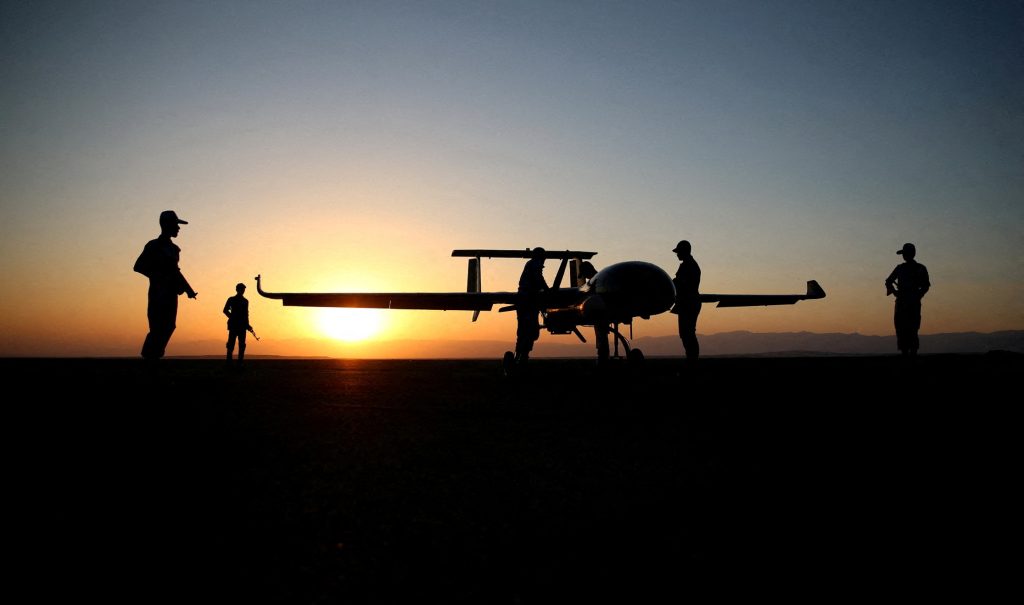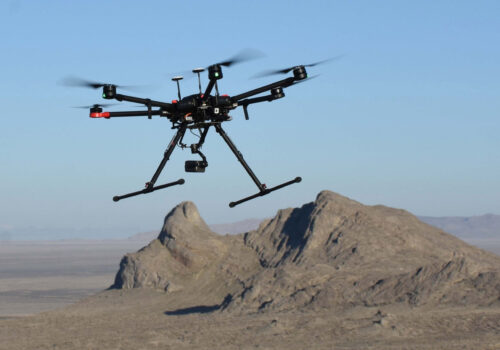Below is an abridged version of the Forward Defense initiative’s Defense Technology Monitor, a bimonthly series tracking select developments in global defense technology and analyzing technology trends and their implications for defense, international security, and geopolitics.
Recent events in countries around the world have highlighted the trends shaping defense technology—and their significant ramifications for global security.
For example, in Japan, the government released a policy on the military use of artificial intelligence (AI). Evolutions in the use of drone technology in Russia, Mexico, and Sudan have brought further attention to the conversation around the use of lethal drones. Meanwhile, the United States revealed more information about a hyper-enabled operator concept it is working on, which would connect troops with technologies they need to make faster decisions and improve situational awareness.
Below is a brief look at these and other changes in how defense technologies are used and deployed globally.
AI and data
As Japan continues to face a low birth rate, which is complicating the military’s recruitment efforts, the Japanese Defense Ministry released its first policy on the use of artificial intelligence. The defense minister argued that as Japan faces demographic pressures, it is increasingly important that each member of the force is as efficient and productive as possible. The new policy is another data point in the trend of using AI in a way that is human-centered.
Autonomous systems
While the use of lethal drones has become a topic of conversation in regard to Russia’s war in Ukraine and other major conflicts around the world, the diffusion of this cheap and effective technology has begun to appear in other contexts as well. Notably, there has been a diffusion of drones to non-state actors. Cartels in Mexico have started operating bomb-dropping drones, resulting in the deaths of Mexican soldiers. Attacks like these began in 2020 but have become alarmingly more frequent over the past year. In addition, a spokesperson from the Sudanese Armed Forces (SAF) said that Abdel Fattah al-Burhan—leader of the SAF—had survived an assassination attempt in the form of a drone attack, which the spokesperson blamed on the Rapid Support Forces (RSF). However, a legal adviser to the RSF said the group was not responsible. Some analysts have said that the RSF has been using drones with more frequency, with attacks directed at army-controlled areas.
Platforms and weapons systems
A new in-depth analysis from National Defense University Press shines a light on the ways drone operators can combat the diverse set of counter-drone measures and tactics being developed and deployed around the world. The analysis inspects technologies including kinetic weapons, directed-energy weapons, and autonomy manipulation, as well as offensive anti-air operations and targets. This analysis is timely, given the value that drones have demonstrated in Ukraine and elsewhere, as well as the growing emphasis on the development and acquisition of more effective counter-drone capabilities.
Human performance enhancement and protection
The US military has shed more light on its development of a hyper-enabled operator concept, which would equip special operations forces with technologies that enhance their situational awareness and accelerate decision making. The concept is the successor to an earlier effort to build an exoskeleton of armor, called the Tactical Assault Light Operator Suit (TALOS), that would improve survivability in combat by offering the operator resistance to small-arms fire.
Manufacturing and industry
This summer, digital engineering company Istari Digital was awarded a contract to develop “Model One.” This new digital platform program is designed to integrate fifty models and simulations from across the Air Force into a unified system, in an effort to adapt to “the ever-evolving landscape of digital warfare,” as Istari CEO Will Roper and backer Eric Schmidt put it in a Wall Street Journal op-ed. The US Army is also pursuing a new platform to speed up the pace, lower the cost, and reduce the risk in weapons systems development. It has also released a new policy aimed at boosting its digital engineering capacity.

Forward Defense, housed within the Scowcroft Center for Strategy and Security, generates ideas and connects stakeholders in the defense ecosystem to promote an enduring military advantage for the United States, its allies, and partners. Our work identifies the defense strategies, capabilities, and resources the United States needs to deter and, if necessary, prevail in future conflict.
Further reading
Wed, Jul 3, 2024
Don’t cut corners on US nuclear deterrence
New Atlanticist By Matthew Kroenig, Mark J. Massa
Bipartisan support for modernizing and expanding the US nuclear arsenal will be essential for the United States to deter its adversaries.
Tue, May 21, 2024
Congress should save the Sentinel ICBM—its true value is more than simply its cost
New Atlanticist By James McCue
The value of the new intercontinental ballistic missile program should be measured over its full lifetime and not just by its current price tag.
Tue, May 7, 2024
The drones are small—the arms race may not be. Here’s how the US can win.
New Atlanticist By Matthew Rose, Kathryn Levantovscaia
With rapid advances in drone technology, the United States needs to develop an updated, comprehensive counter-drone strategy.
Image: A view of a drone during a military exercise in an undisclosed location in Iran, in this handout image obtained on August 24, 2022. Iranian Army/WANA (West Asia News Agency)/Handout via REUTERS



